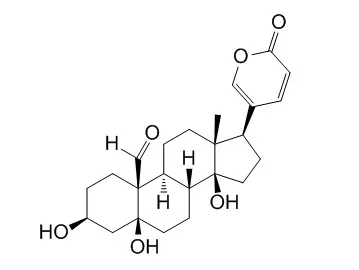Hellebrigenin, one of bufadienolides belonging to cardioactive steroids, was found in skin secretions of toads and plants of Helleborus and Kalanchoe genera.
METHODS AND RESULTS:
In searching for natural constituents with anti-hepatoma activities, we found that Hellebrigenin, isolated from traditional Chinese medicine Venenum Bufonis, potently reduced the viability and colony formation of human hepatocellular carcinoma cells HepG2, and went on to explore the underlying molecular mechanisms. Our results demonstrated that Hellebrigenin triggered DNA damage through DNA double-stranded breaks and subsequently induced cell cycle G2/M arrest associated with up-regulation of p-ATM (Ser(1981)), p-Chk2 (Tyr(68)), p-CDK1 (Tyr(15)) and Cyclin B1, and down-regulation of p-CDC25C (Ser(216)). It was also found that Hellebrigenin induced mitochondrial apoptosis, characterized by Bax translocation to mitochondria, disruption of mitochondrial membrane potential, release of cytochrome c into cytosol and sequential activation of caspases and PARP. In addition, Akt expression and phosphorylation were inhibited by Hellebrigenin, whereas Akt silencing with siRNA significantly blocked cell cycle arrest but enhanced apoptosis induced by Hellebrigenin. Activation of Akt by human insulin-like growth factor I (hIGF-I) could obviously attenuate Hellebrigenin-induced cell death.
CONCLUSIONS:
In summary, our study is the first to report the efficacy of Hellebrigenin against HepG2 and elucidated its molecular mechanisms including DNA damage, mitochondria collapse, cell cycle arrest and apoptosis, which will contribute to the development of Hellebrigenin into a chemotherapeutic agent in the treatment of liver cancer. |






 Cell. 2018 Jan 11;172(1-2):249-261.e12. doi: 10.1016/j.cell.2017.12.019.IF=36.216(2019)
Cell. 2018 Jan 11;172(1-2):249-261.e12. doi: 10.1016/j.cell.2017.12.019.IF=36.216(2019) Cell Metab. 2020 Mar 3;31(3):534-548.e5. doi: 10.1016/j.cmet.2020.01.002.IF=22.415(2019)
Cell Metab. 2020 Mar 3;31(3):534-548.e5. doi: 10.1016/j.cmet.2020.01.002.IF=22.415(2019) Mol Cell. 2017 Nov 16;68(4):673-685.e6. doi: 10.1016/j.molcel.2017.10.022.IF=14.548(2019)
Mol Cell. 2017 Nov 16;68(4):673-685.e6. doi: 10.1016/j.molcel.2017.10.022.IF=14.548(2019)